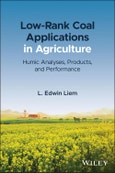Low-Rank Coal Applications in Agriculture explores the commercialization and marketing potential of low-rank coal, which is rich in organic matter and humic substances. The author--a noted expert on the topic--clearly shows from a practical perspective, that rather than using it as an energy source, this material can be applied for the agricultural sector.
The author investigates low-rank coal;s potential as used in dry and liquid humic products. This book discusses both raw materials and commercial products, and provides data on improved soil quality, crop yields, and livestock productivity.
This groundbreaking book:
- details how this material can benefit agriculture; thus positioning coal in the more "green sector" type of industry
- presents original data collected from laboratories and agricultural fields, and summarizes literature on the science and regulation of low-rank coal and humic substances
Written for field practitioners, end users, marketers, operators, regulators, researchers, and academics, Low-Rank Coal Applications in Agriculture is the first book on the market to explore the real-life use of low-rank coal for the agricultural sector.
Table of Contents
List of Figures ix
List of Tables xi
Units xv
1 Introduction 1
Reference 7
2 Low-Rank Coal 9
2.1 Overview 9
2.2 Material Quality 13
2.3 Material Safety 17
2.4 Safety Documentation 27
2.5 Closure 29
Reference 31
3 Humic Analyses 37
3.1 Overview 37
3.2 Extraction and Analyses 41
3.2.1 Extraction 42
3.2.2 Physical Properties 45
3.2.3 Gravimetric 45
3.2.4 Colorimetric 48
3.2.5 Combined Colorimetric and Gravimetric 51
3.2.6 Organic Carbon 52
3.2.7 Reactive Functional Groups 53
3.2.8 Comparison Among Analytical Methods 55
3.2.9 Further Studies on Analytical Methods 57
3.2.9.1 Effects of pH on Colorimetric Method 57
3.2.9.2 Modified ISO 19822 60
3.2.9.2.1 Background 60
3.2.9.2.2 Materials and Methods 63
3.2.9.2.3 Laboratory Work 66
3.2.9.2.4 Results 69
3.2.9.2.5 Discussion 73
3.2.9.2.6 Conclusion and Recommendation 77
3.3 Organic Matter Product Comparison 78
3.4 Closure 93
Reference 94
4 Applications in Agriculture 103
4.1 Overview 103
4.2 Benefits of Humic Substances 105
4.3 Disadvantages of Humic Substances 115
4.4 Efficacy Results for Soil and Crops 116
4.5 Efficacy Results for Livestock 146
4.6 Product Registration 152
4.6.1 Regional Registration for Crops 154
4.6.2 Organic Registration for Crops 162
4.6.3 Registration for Livestock 165
4.7 Closure 169
Reference 170
5 Commercial Humic Products 191
5.1 Overview 191
5.2 Raw Material 191
5.3 Dry HS 194
5.4 Liquid HA 198
5.5 Liquid FA 201
5.6 Enhanced Liquid Products 203
5.7 Pelletized HS 205
5.8 Dry Soluble HS 207
5.9 Product Handling 209
5.10 Closure 212
Reference 213
6 Product Performance 217
6.1 Overview 217
6.2 Applicability of Dry and Pelletized HS 218
6.3 Applicability of Liquid HA 224
6.4 Applicability of Liquid FA 228
6.5 Applicability of Dry Soluble HS 230
6.6 Product Efficacy Projects 231
6.6.1 Rice 233
6.6.2 Wheat (1) 235
6.6.3 High Salinity Soil (1) 238
6.6.4 High Salinity Soil (2) 241
6.6.5 Lettuce 245
6.6.5.1 Materials and Methods 246
6.6.5.2 Results and Discussion 249
6.6.5.3 Conclusion 253
6.6.6 Canola 254
6.6.7 Lentil 257
6.6.8 Soil Compaction 260
6.6.9 Barley 264
6.6.10 Wheat (2) 267
6.6.11 Other Soil and Crop Product Efficacy Projects 269
6.6.12 Beef Cattle 277
6.7 Cost-Benefit Study 283
6.8 Closure 290
Reference 294
7 Conclusion 299
Reference 307
Index 309
Biography 319








